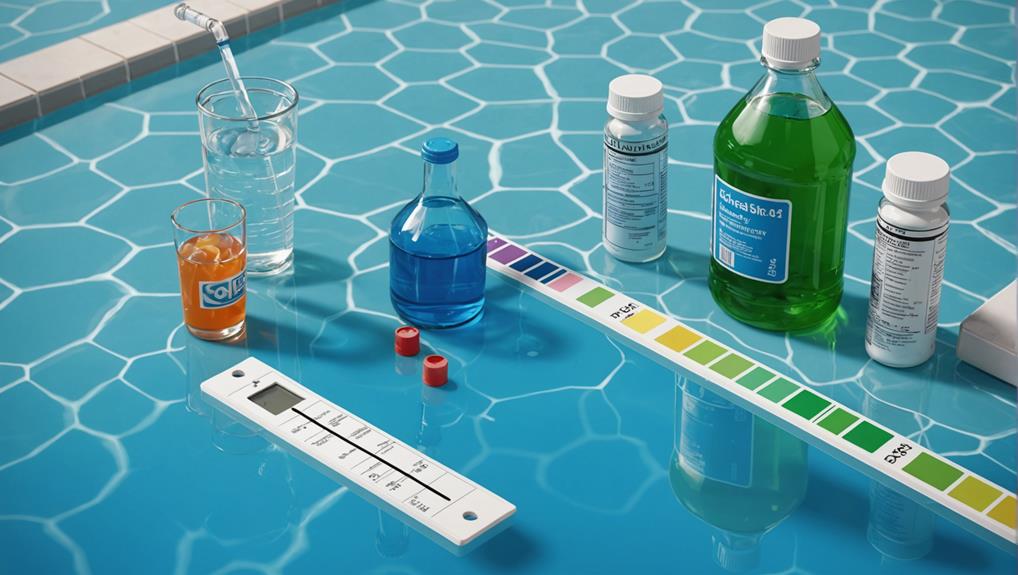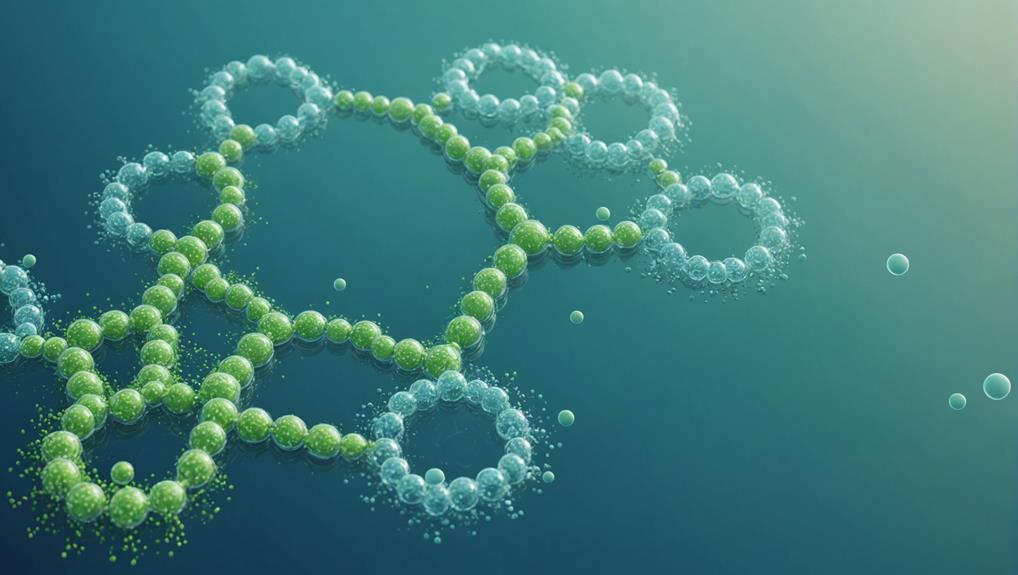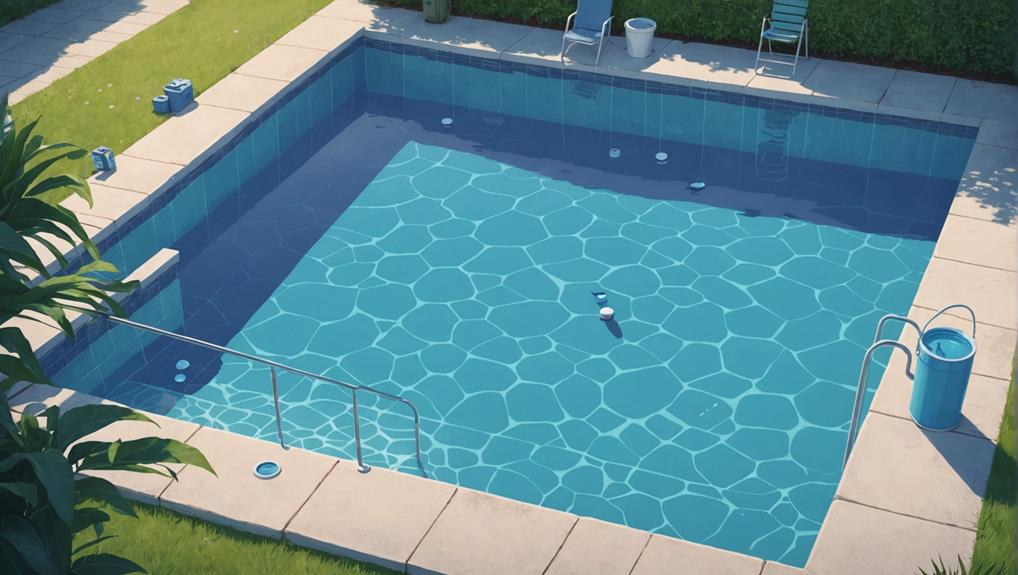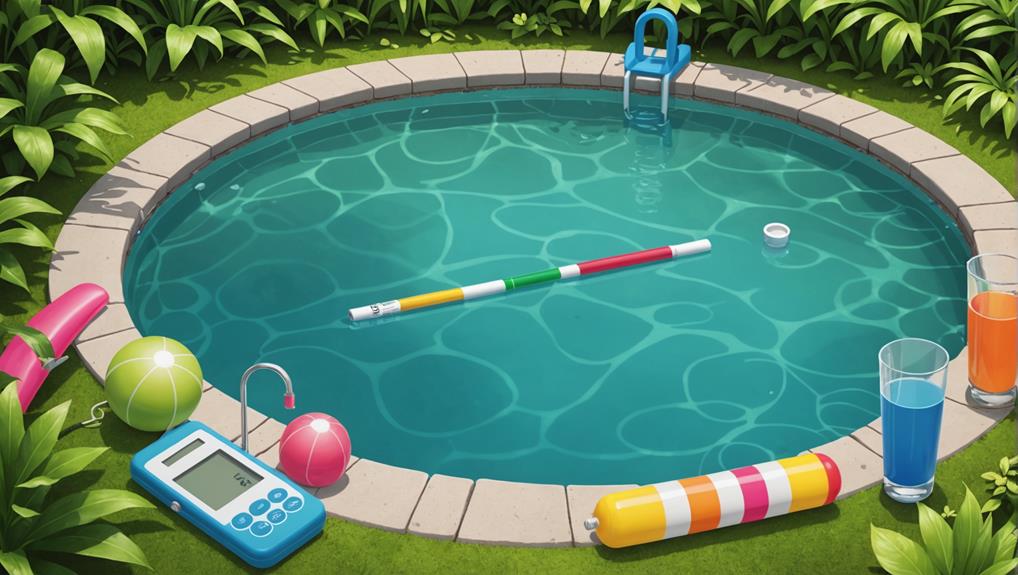You're about to venture into the world of pool maintenance, where 7 essential elements stand between you and a perfectly balanced pool ecosystem. To achieve chemical balance, you'll need to understand sanitizer, water balancer, and other chemical roles. Regularly test and measure pH, alkaline, and chlorine levels to maintain a safe and healthy swimming environment. Adjust alkalinity and pH levels, balance calcium hardness and chlorine, and monitor cyanuric acid and dissolved solids. Don't forget to shock and oxidize your pool water regularly. By following these 7 essentials, you'll be well on your way to maintaining a crystal-clear, safe, and healthy pool – and there's more to explore to guarantee your pool is always in top shape.
Key Takeaways
- Regularly test and measure pH, alkalinity, calcium hardness, and sanitizer levels to maintain a safe and healthy swimming environment.
- Adjust alkalinity levels to 80-120 ppm and pH levels to 7.4-7.6 to prevent fluctuations and ensure effective sanitizer performance.
- Maintain calcium hardness levels between 200-400 ppm to prevent etching and corrosion, and chlorine levels between 1-3 ppm for effective sanitation.
- Monitor cyanuric acid levels (30-50 ppm) and Total Dissolved Solids (TDS) to prevent corrosion, scaling, and cloudy water.
- Shock and oxidize pool water regularly to break down contaminants, eliminate chloramines, and maintain a clean and healthy pool environment.
Understanding Pool Chemicals Basics
As you begin to navigate the world of pool maintenance, you must understand the fundamentals of pool chemicals, which can be broadly categorized into sanitizers, water balancers, oxidizers, niche-purpose specialty chemicals, and alkalinity increasers.
Sanitizers, like chlorine, are essential for disinfecting the water and killing bacteria, viruses, and other microorganisms.
Water balancers, on the other hand, help adjust the pool water's pH, alkalinity, and calcium hardness levels to ideal ranges. For instance, you may need to use acid to decrease pH or sodium bicarbonate to increase alkalinity.
Balancing pool chemicals is vital to achieving a stable pool water balance. If chemical levels are off, it can lead to issues like cloudy water, eye irritation, or even equipment damage.
Understanding the different types of pool chemicals and their roles is key to maintaining a safe and healthy swimming environment. By grasping these basics, you'll be better equipped to make informed decisions about balancing your pool's chemical levels and ensuring a perfect pool water balance.
Testing and Measuring Pool Water
Your pool water's chemical balance relies heavily on accurate testing and measurement, which is why regular checks on pH, alkaline, and chlorine levels are crucial for maintaining a safe and healthy swimming environment. You have several options for testing and measuring pool water, each with its own advantages.
| Testing Method | Description |
|---|---|
| Pool Test Strips | Quickly measure pH, alkaline, and chlorine levels |
| Pool Testing Kits | Mix small water samples with a reagent for accurate readings |
| Digital Pool Testers | Connect to smartphones for detailed, real-time monitoring |
Regular water testing, ideally at least two to three times per week, promotes cloud-free, crystal-clear, and safe pool water for swimmers. However, testing frequency may vary depending on pool usage, environmental factors, and individual pool characteristics, so developing a customized testing schedule is crucial. By regularly testing and measuring your pool water, you'll be able to identify and address any chemical imbalances before they become major issues, maintaining a perfect balance of pH, alkalinity, calcium hardness, and chlorine levels.
Adjusting Alkalinity and Ph Levels

By regularly testing and adjusting alkalinity and pH levels, you can prevent fluctuations that disrupt the delicate balance of your pool's chemistry.
To achieve ideal water chemistry, follow these guidelines:
Adjust alkalinity levels to fall within the ideal range of 80-120 parts per million (ppm) to prevent pH fluctuations and promote effective sanitizer performance. You can raise alkalinity levels by adding sodium bicarbonate (baking soda) and lower them with muriatic acid or sodium bisulfate.
Maintain pH levels between 7.4 and 7.6 to prevent eye irritation, corrosion, and scaling, as well as to maximize sanitizer effectiveness. Use pH increasers like soda ash to raise pH levels and pH decreasers like muriatic acid or sodium bisulfate to lower them.
Regularly testing and adjusting alkalinity and pH levels is vital, as imbalances can lead to cloudy water, algae growth, and equipment damage.
Balancing Calcium Hardness and Chlorine
Properly balancing calcium hardness and chlorine levels in your pool is critical to preventing damage to the pool and its equipment, as well as ensuring the comfort and safety of swimmers. Calcium hardness, measured in parts per million (ppm), should be maintained between 200-400 ppm to prevent etching of the pool surface and equipment corrosion. Chlorine levels, on the other hand, should be kept between 1-3 ppm to effectively sanitize the pool water.
| Parameter | Ideal Range | Effect of Imbalance |
|---|---|---|
| Calcium Hardness | 200-400 ppm | Etching, corrosion, or scaling |
| Chlorine Levels | 1-3 ppm | Ineffective sanitation or eye irritation |
| Calcium Chloride | 200-400 ppm | Increased calcium hardness |
To achieve this balance, you can use a calcium hardness increaser to raise the calcium level, and adjust chlorine levels according to your pool's specific needs. Remember to always consider the interplay between calcium hardness, alkalinity, pH levels, and total dissolved solids to maintain optimal pool water chemistry and water balance. By doing so, you'll ensure a safe, comfortable, and well-maintained swimming environment.
Cyanuric Acid and Dissolved Solids

You must maintain ideal levels of cyanuric acid and dissolved solids to guarantee your pool water remains safe, clear, and well-balanced.
Cyanuric acid, a stabilizer, protects chlorine from degradation due to sunlight, thereby supporting a consistent and effective sanitizing process. Ideal CYA levels range from 30-50 ppm.
To achieve proper pool water chemistry, you must also monitor Total Dissolved Solids (TDS) levels. High TDS levels can lead to cloudy water, eye irritation, and equipment damage.
Ideal CYA levels: Maintain 30-50 ppm to promote chlorine stability and effectiveness.
TDS monitoring: Regularly check TDS levels to prevent corrosion and scaling.
TDS threshold: Partially drain and refill your pool if TDS levels exceed 2,000 ppm.
Regular testing: Monitor CYA and TDS levels regularly to maintain a balanced and safe pool environment.
Shocking and Oxidizing Pool Water
After maintaining ideal levels of cyanuric acid and dissolved solids, it's time to focus on another critical aspect of pool water chemistry: shocking and oxidizing the water to eliminate built-up contaminants and maintain a clean and healthy pool environment. Shocking involves adding a high dose of oxidizer to break down and eliminate contaminants like chloramines, sweat, and dirt that can cause cloudy water and unpleasant odors. When to shock your pool? When the free chlorine level is zero or very low, indicating the presence of chloramines that can only be removed through oxidation.
| Parameter | Ideal Level | Effect of Shocking |
|---|---|---|
| Free Chlorine | 1-3 ppm | Increases to normal level |
| Alkalinity | 80-120 ppm | Remains stable |
| Calcium Hardness | 200-400 ppm | Remains stable |
Regular shocking, typically every 1-2 weeks, can help maintain a clean and healthy pool environment, reduce eye irritation and chlorine smell, and extend the lifespan of pool equipment and accessories. Remember to shock at night, as oxidizers can break down quickly in sunlight, and run the filter continuously for 24 hours after shocking to remove any remaining contaminants.
What Are the Essential Chemicals Needed for Maintaining Pool Balance?
Maintaining the proper chemical levels for pools is essential for a balanced and healthy swimming environment. The primary chemicals needed include chlorine for sanitizing, pH increaser or decreaser for controlling acidity, alkalinity increaser for stabilizing pH, and calcium hardness increaser to prevent equipment damage. Testing and adjusting these chemicals regularly is crucial for pool maintenance.
Maintaining Balanced Pool Water

Test your pool water regularly to maintain balanced levels of pH, alkalinity, calcium hardness, and sanitizers, as neglecting these crucial parameters can lead to a host of problems, including corrosion, skin and eye irritation, and equipment damage.
To maintain a safe and healthy swimming environment, you need to regularly test and adjust these levels.
Maintain a pH range of 7.2 to 7.8 to prevent eye irritation, skin problems, and damage to the pool and its equipment.
Keep alkalinity levels in check to stabilize the pH and prevent sudden changes.
Maintain calcium hardness levels between 200 and 400 ppm to prevent corrosion and scaling of the pool and its equipment.
Guarantee sanitizer levels are adequate to kill bacteria and other microorganisms, and to prevent the growth of algae.
Frequently Asked Questions
How to Get Pool Chemicals Balanced?
To get pool chemicals balanced, you'll need to test the water, adjusting chemical levels, alkalinity, and pH ranges accordingly. Maintain ideal calcium content, stabilize pH, and sanitize with chlorine types, considering shock treatment for maximum sanitizer effectiveness.
How Do You Fix a Chemical Imbalance in a Pool?
You fix a chemical imbalance in a pool by identifying the issue, then addressing pH swings with soda ash or acid, alkalinity spikes with sodium bicarbonate, calcium crunch with calcium chloride, and chlorine overdose with a shock treatment.
How Often Do You Need to Balance Pool Chemicals?
You should balance pool chemicals at least weekly, but during peak summer seasons or after heavy rainfall, you may need to test and adjust daily, considering factors like bather load, pool age, and weather fluctuations.
What Contributes to Water Balance in a Pool?
You understand that water balance in a pool is influenced by factors like pH levels, water temperature, alkalinity factors, calcium hardness, stabilizer levels, sanitizer types, bather load, rainfall impact, evaporation rates, and nitrogen sources, which all interact to achieve ideal balance.
Conclusion
With these 7 essentials in your toolkit, you've got the keys to access a crystal-clear oasis.
Imagine diving into a pool where every molecule is in harmony, like a symphony of chemical balance.
The water sparkles like diamonds, and every swimmer emerges feeling refreshed, not ravaged by harsh chemicals.
By mastering these principles, you've created a haven of health and happiness for all who take the plunge.

I’m Max, the founder and chief pool enthusiast behind Pool Pro Tips. As a passionate pool owner and cleaning expert, I created this website to share my knowledge and experience with you, helping you to keep your pool sparkling clean and safe for years to come.

